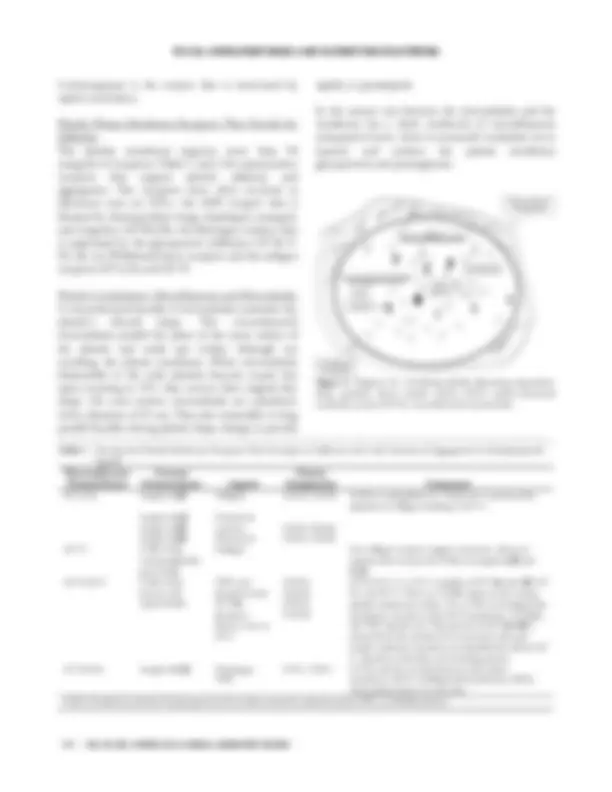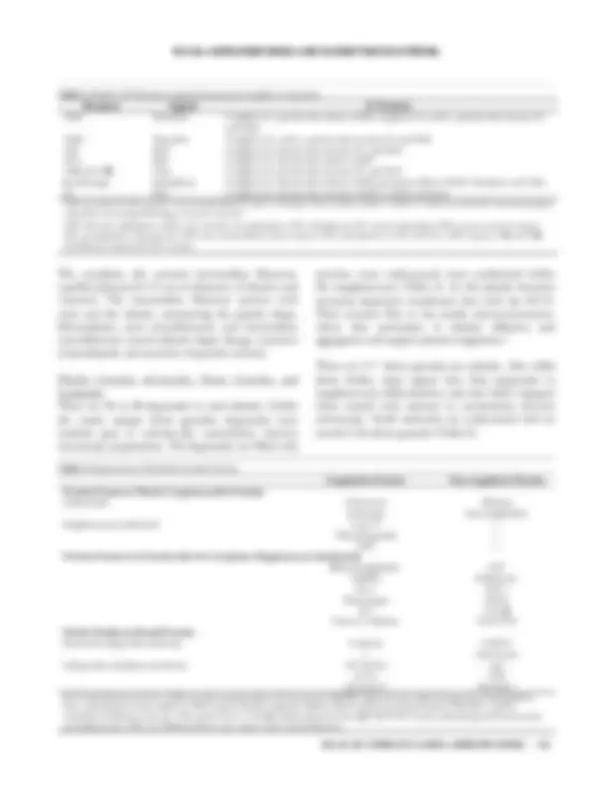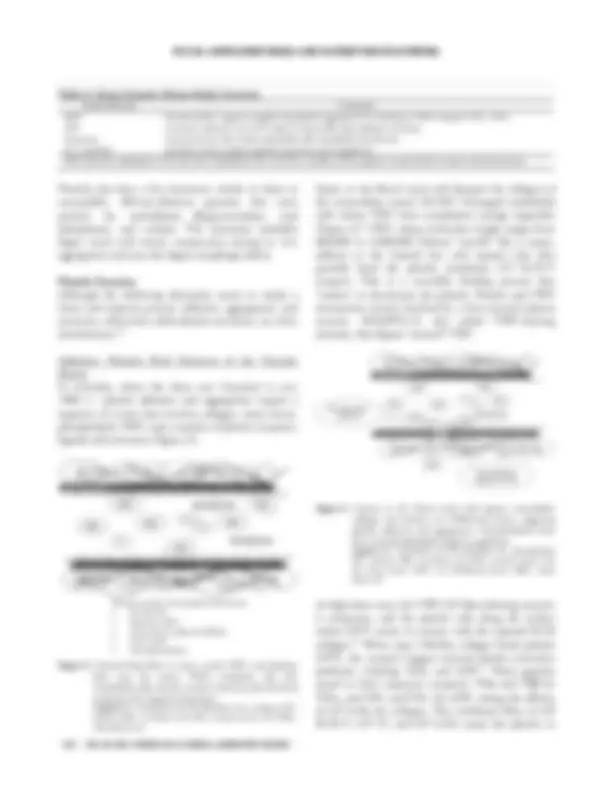





Study with the several resources on Docsity

Earn points by helping other students or get them with a premium plan


Prepare for your exams
Study with the several resources on Docsity

Earn points to download
Earn points by helping other students or get them with a premium plan
Community
Ask the community for help and clear up your study doubts
Discover the best universities in your country according to Docsity users
Free resources
Download our free guides on studying techniques, anxiety management strategies, and thesis advice from Docsity tutors
Demonstrate the relationship of platelets and the plasma coagulation mechanism. ABBRVIATIONS: ADP-adenosine diphosphate; ATP- adenosine triphosphate; CAM-cell ...
Typology: Exams
1 / 7

This page cannot be seen from the preview
Don't miss anything!




Platelet Structure Platelet Plasma Membrane The platelet plasma membrane is a standard bilayer composed of proteins and lipids (Figure 1). The predominant lipids are phospholipids, which form the basic structure, and cholesterol, which distributes asymmetrically throughout the phospholipids. The phospholipids form a bilayer with their polar heads oriented toward aqueous environments—toward the plasma externally and the cytoplasm internally. Their fatty acid chains, esterified to carbons 1 and 2 of the phospholipid triglyceride backbone, orient toward each other, perpendicular to the plane of the membrane, to form a hydrophobic barrier sandwiched within the hydrophilic layers. Figure 1. The platelet possesses a standard biological membrane composed of a phospholipid bilayer with polar head groups oriented toward the aqueous plasma and cytoplasm and nonpolar fatty acid tails that orient toward the center. The phospholipid backbone is interspersed with esterified cholesterol. A series of transmembranous proteins communicate with microfilaments and enzymes. The neutral phospholipids phosphatidylcholine and sphingomyelin predominate in the plasma layer; the anionic or polar phospholipids phosphatidylinositol, phosphatidylethanolamine, and phosphatidylserine predominate in the inner, cytoplasmic layer. These phospholipids, especially phosphatidylinositol, support platelet activation by supplying arachidonic acid, an unsaturated fatty acid that becomes converted to the eicosanoids prostaglandin and thromboxane A 2 during platelet activation. Phosphatidylserine flips to the outer surface upon activation and is the charged phospholipid surface on which the coagulation enzymes, especially coagulation factor complex VIII and IX and coagulation factor complex X and V, assemble.2, Esterified cholesterol moves freely throughout the hydrophobic internal layer, exchanging with unesterified cholesterol from the surrounding plasma. Cholesterol stabilizes the membrane, maintains fluidity, and helps control the transmembranous passage of materials. Anchored within the membrane are glycoproteins and proteoglycans; these support surface glycosaminoglycans, oligosaccharides, and glycolipids. The platelet membrane surface, called the glycocalyx , also absorbs albumin, fibrinogen, and other plasma proteins, in many instances transporting them to storage organelles within using a process called endocytosis_._ At 20–30 nm, the platelet glycocalyx is thicker than the analogous surface layer of leukocytes or erythrocytes. This thick layer is adhesive and responds readily to hemostatic demands. The platelet carries its functional environment with it, meanwhile maintaining a negative surface charge that repels other platelets, other blood cells, and the endothelial cells that line the blood vessels. The plasma membrane is selectively permeable, and the membrane bilayer provides phospholipids that support platelet activation internally and plasma coagulation externally. The anchored glycoproteins support essential plasma surface–oriented glycosylated receptors that respond to cellular and humoral stimuli, called ligands or agonists , transmitting their stimulus through the membrane to internal activation organelles. Surface-Connected Canalicular System The plasma membrane invades the platelet interior, producing its unique surface-connected canalicular system (SCCS; Figure 2). The SCCS twists sponge-like throughout the platelet, storing additional quantities of the same hemostatic proteins in the glycocalyx. Dense Tubular System Parallel and closely aligned to the SCCS is the dense tubular system (DTS), a remnant of the rough endoplasmic reticulum. The DTS sequesters Ca2+^ and bears enzymes that support platelet activation. These enzymes include phospholipase A 2 , cyclooxygenase, and thromboxane synthetase, which support the eicosanoid synthesis pathway that produces thromboxane A 2.
Table 2. Platelet STR Receptor-Ligand Interactions Coupled to G proteins Receptor Ligand G Proteins PAR1 Thrombin Coupled to G 1 protein that reduces cAMP; coupled to Gq and G 12 proteins that increase IP 3 and DAG PAR4 Thrombin Coupled to Gq and G 12 proteins that increase IP 3 and DAG P2Y 1 ADP Coupled to Gq protein that increases IP 3 and DAG P2Y 12 ADP Coupled to G 1 protein that reduces cAMP TPα and TPβ TXA 2 Coupled to Gq protein that increases IP 3 and DAG α 2 - adrenergic Epinephrine Coupled to G 1 protein that reduces cAMP; potentiates effects of ADP, thrombin, and TXA 2 IP PGI 2 Coupled to GS protein that increases cAMP to inhibit activation STRs are named for their peculiar “seven-transmembranous repeat” anchorage. These receptors mediate “outside-in” platelet activation by transmitting signals initiated by external ligand binding to internal G proteins. ADP, Adenosine diphosphate; cAMP, cyclic adenosine monophosphate; DAG, diacylglycerol; IP 3 , inositol triphosphate; PAR, protease-activated receptor; PGI 2 , prostaglandin I 2 (prostacyclin); STR, seven-transmembrane repeat receptor; TXA 2 , thromboxane A2; P2Y 1 and P2Y 12 , ADP receptors; TPα and TPβ, thromboxane receptors; IP, PGI 2 receptor. The cytoplasm also contains intermediate filaments, ropelike polymers 8–12 nm in diameter, of desmin and vimentin. The intermediate filaments connect with actin and the tubules, maintaining the platelet shape. Microtubules, actin microfilaments, and intermediate microfilaments control platelet shape change, extension of pseudopods, and secretion of granule contents. Platelet Granules: α-Granules, Dense Granules, and Lysosomes There are 50 to 80 α-granules in each platelet. Unlike the nearly opaque dense granules, α-granules stain medium gray in osmium-dye transmission electron microscopy preparations. The α-granules are filled with proteins, some endocytosed, some synthesized within the megakaryocyte (Table 3). As the platelet becomes activated, α-granule membranes fuse with the SCCS. Their contents flow to the nearby microenvironment, where they participate in platelet adhesion and aggregation and support plasma coagulation.^4 There are 2–7 dense granules per platelet. Also called dense bodies, these appear later than α-granules in megakaryocyte differentiation and stain black (opaque) when treated with osmium in transmission electron microscopy. Small molecules are endocytosed and are stored in the dense granules (Table 4). Table 3. Representative Platelet α-Granule Proteins Coagulation Proteins Non-coagulation Proteins Proteins Present in Platelet Cytoplasm and α - Granules Endocytosed Fibronectin Albumin Fibrinogen Immunoglobulins Megakaryocyte-synthesized Factor V — Thrombospondin — VWF — Proteins Present in α - Granules But Not Cytoplasm (Megakaryocyte-Synthesized) β-thromboglobulin EGF HMWK Multimerin PAI- 1 PDC Plasminogen PDGF PF4 TGF-β Protein C inhibitor VEGF/VPF Platelet Membrane-Bound Proteins Restricted to α-granule membrane P-selectin GMP — Osteonectin In α-granule and plasma membrane GP IIb-IIIa cap GP IV CD GP Ib-IX-V PECAM- 1 EGF, Endothelial growth factor; GMP, guanidine monophosphate; GP, glycoprotein; HMWK, high-molecular-weight kininogen; Ig, immunoglobulin; PAI-1, plasminogen activator inhibitor-1; PDCI, platelet-derived collagenase inhibitor; PDGF, platelet-derived growth factor; PECAM-1, platelet– endothelial cell adhesion molecule-1; PF4, platelet factor 4; TGF-β, transforming growth factor-β; VEGF/VPF, vascular endothelial growth factor/vascular permeability factor; VWF, von Willebrand factor; cap1, adenyl cyclase–associated protein.
Table 4: Dense-Granule (Dense Body) Contents Small Molecule Comment ADP Nonmetabolic, supports neighboring platelet aggregation by binding to ADP receptors P2Y 1 , P2Y 12 ATP Function unknown, but ATP release is detectable upon platelet activation Serotonin Vasoconstrictor that binds endothelial cells and platelet membranes Ca2+^ and Mg2+^ Divalent cations support platelet activation and coagulation ADP, Adenosine diphosphate; ATP, adenosine triphosphate; P2Y 1 and P2Y 12 , members of the purigenic receptor family (receptors that bind purines). Platelets also have a few lysosomes, similar to those in neutrophils, 300 - nm-diameter granules that stain positive for arylsulfatase, β-glucuronidase, acid phosphatase, and catalase. The lysosomes probably digest vessel wall matrix components during in vivo aggregation and may also digest autophagic debris. Platelet Function Although the following discussion seems to imply a linear and stepwise process, adhesion, aggregation, and secretion, collectively called platelet activation, are often simultaneous.5, Adhesion: Platelets Bind Elements of the Vascular Matrix In arterioles, where the shear rate (viscosity) is over 1000 s-^1 , platelet adhesion and aggregation require a sequence of events that involves collagen, tissue factor, phospholipid, VWF, and a number of platelet receptors, ligands and activators (Figure 3).^7 Normal vascular intimasuppress hemostasis:
Figure 5. Eicosanoid synthesis. Ligands (agonists) ADP, thrombin, collagen, or epinephrine bind their respective membrane receptors. The combination activates phospholipase A 2. Phospholipase A 2 releases arachidonic acid from membrane phosphatidyl inositol. Arachidonic acid is acted upon by cyclooxygenase, peroxidase, and thromboxane synthase to produce TXA 2 , which activates the platelet. When reagent arachidonic acid is used as an agonist, it bypasses the membrane and directly enters the eicosanoid synthesis pathway. Legend: ADP, adenosine diphosphate; PgG 2 , prostaglandin G 2 ; PgH 2 , prostaglandin H 2 ; TXA 2 , thromboxane A 2. REFERENCES